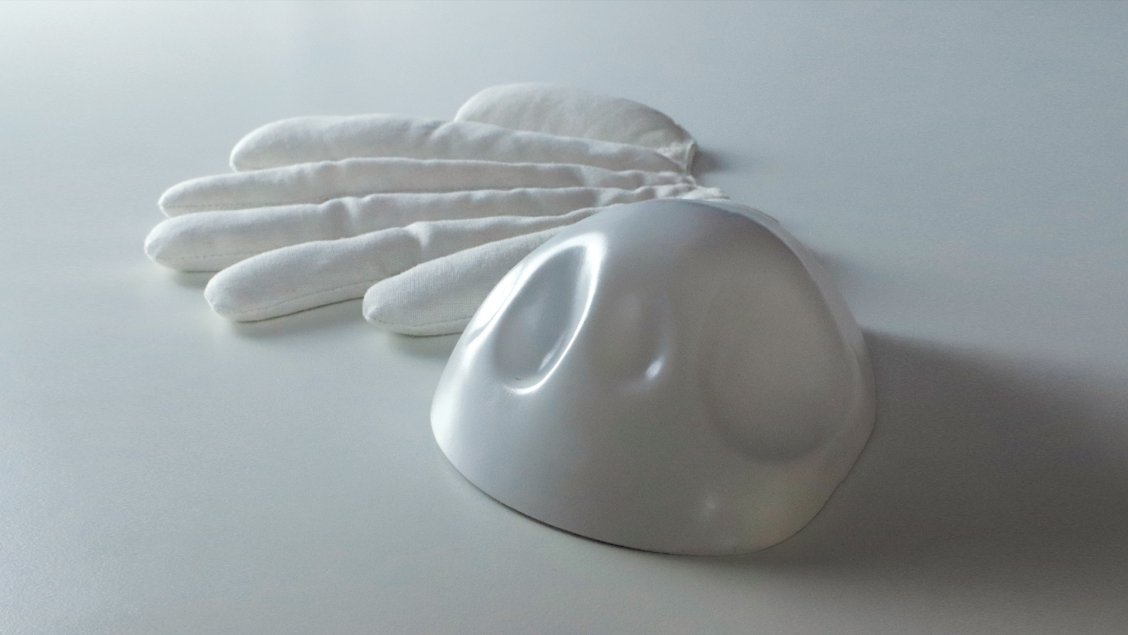Natálie Horská designed a communicator connecting patients with their families
20/9/2023
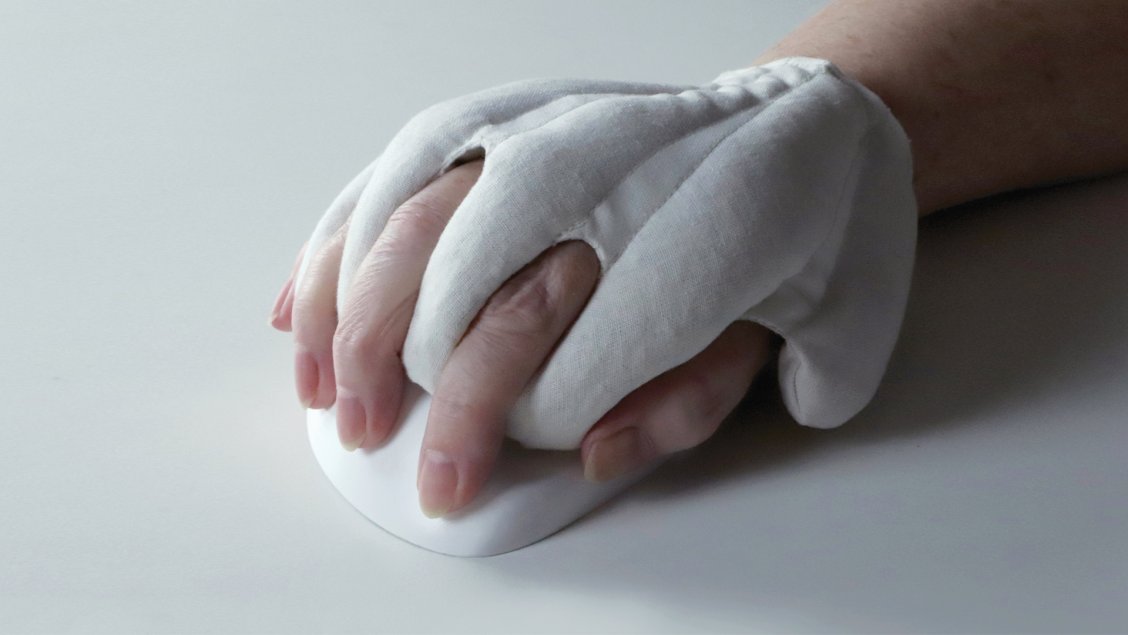
A communicator for palliative care is a challenging topic. Were you led to it through personal experience?
Our studio's assignment was funeral design, which is usually associated with mourning. However, our studio heads Marián Karel and Josef Šafařík wanted us to work with the theme in a more complex way. I thought about what precedes death and how to make this period more pleasant. We were starting during another wave of covid, my friend's dad was dying in the intensive care unit and she hadn't had a chance to say goodbye to him. So I wanted to connect people who couldn't be together.
I was inspired by two nurses in Sao Paulo, Brazil, who filled rubber gloves with warm water and put them on patients' hands during the pandemic. The patients felt like they had someone at their bedside. The concept of the lower part of the device builds on an earlier project also created in the Karel studio. Barbara Rakovská provided non-verbal communication of separated partners with touchpads to convey touch. My product provides both contact with the nurses, who must heat the upper textile glove, and with the distant loved one. The patient’s loved one borrows the other part of the communicator, takes it home and is connected to the patient by touch.
During the design process you had to deal with the phenomenon of the "uncanny valley". Why was it important not to imitate the human hand?
The expression uncanny valley comes from robotics. As long as humanoids have stylized features, we accept them much better. When they look too much like a human, the brain latches on to subtle variations that start to create insecurities. In my case, I solved this problem with a top-heat pad. If it looked like a human hand, users would feel that this strange object might grip them and not let go. We don't want to mislead patients, it's still just a substitute to help relieve some of the stress. The glove is weighted, filled with flax seeds, and adapts to the nuances of the hospitalized person's hand.
Why flaxseed?
Flaxseed heated in a microwave oven, for example, can give off heat for quite a long time. Nowadays they can be found in menstrual pain relief products. The seeds can give off heat for about an hour. Even after they have cooled down, they absorb human heat and are much more comfortable to the touch than, for example, cold plastic.
The heating function is also integrated into the product to maintain contact with personnel. The product requires nurses monitor the patient and regularly change the pad. Of course, I can't solve all the ethical problems in healthcare, but I have tried to create at least a small safeguard.
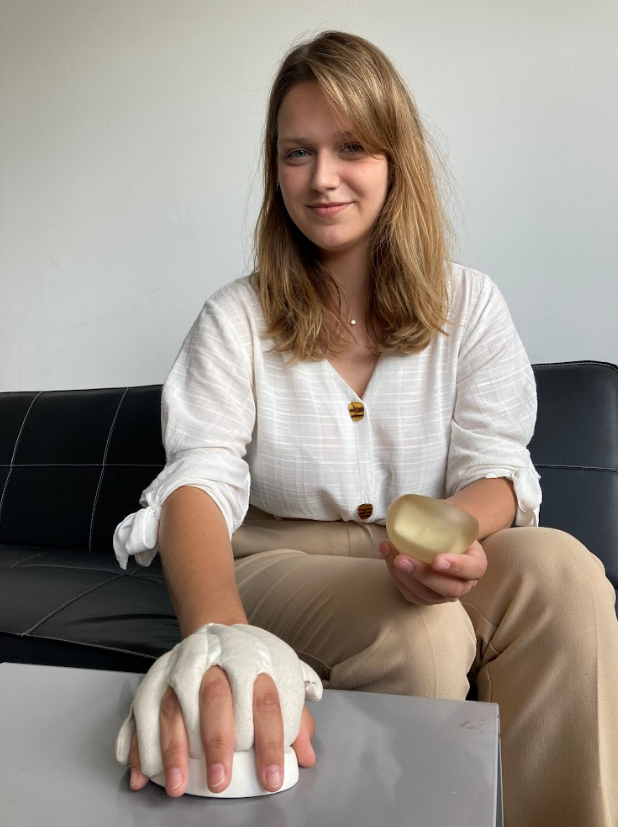
Let's focus on the communicator itself. How does it work technically?
A patient in hospital places their hand on a pad while their loved takes home a communicator. Technically, these are made in a similar way. At the point of contact with one’s fingers, there is a sensing part, similar to the touchpad of a laptop. The device has touch sensors telling in which direction and with what intensity we have touched it.
The data is sent to a second device and the piezoelectric actuators send out gentle directional vibrations. These spread in a line, simulating a touch. We worked on the technical solution with the Human and Computer Interaction (HCI) department of the Faculty of Electrical Engineering. As designers, we come up with different concepts, but we don't know the technical solutions. Associate Professor Míkovec and his colleagues consult with us on the feasibility, which is written back into the formal aspects of the product.
A problematic situation can arise, for example, when the user loses their concentration and, in a state of stress, continues to unthinkingly rub the communicator in repeated motions for an extended period. At this point, the user can unwittingly transfer the stress to the other party as well, and that is a kind of situation I’d still like to address with HCI in the future. We still have long road ahead of in software development for the product.
Why don't all the communicators look alike?
Each person is in a different situation, which is reflected in the ergonomics of the device. A patient lying in the intensive care unit will have their hand on it and will usually not be able to interact with the product in any other way. I therefore investigated the natural position of the hand so that the device would not cause defects and pain in the wrist.
The second communicator fits into the palm of the hand and also follows the shape of the patient's hand at the bedside. The stimuli are inversely transmitted. Thus, when a loved one touches his or her product, the same impulse appears on the communicator in the palm of the hospitalized patient's hand.
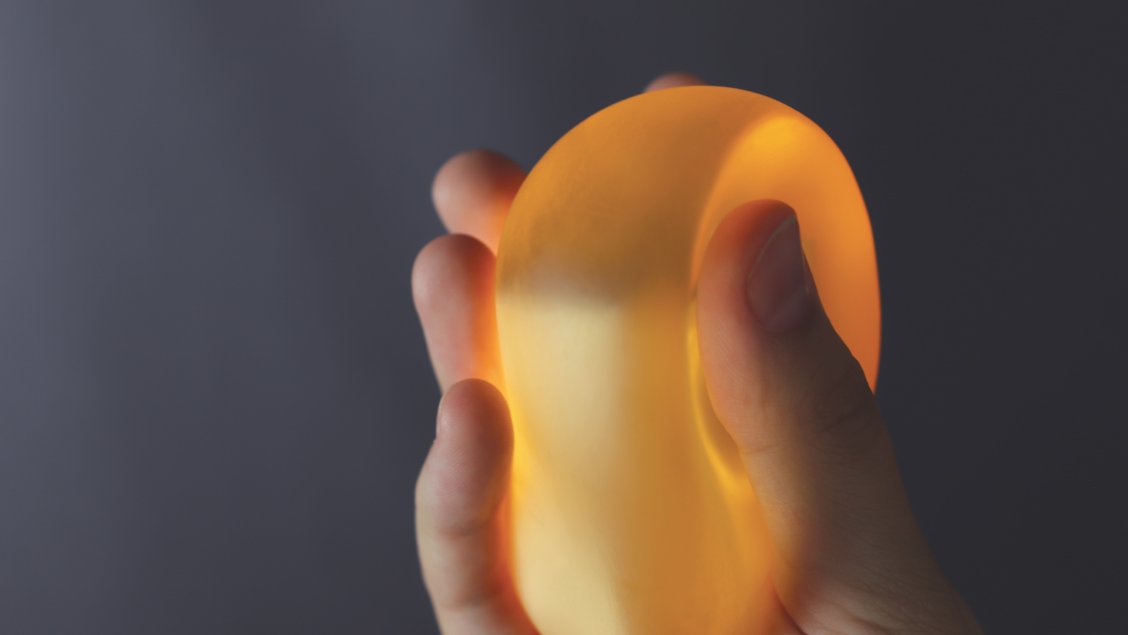
The shape of the communicator is very complex, organic. How did you model it?
I start with clay models, and I test them to see if their ergonomics work. I photograph the model from all sides and convert it into 3D software. I tweak the shape in the software, print it out on a 3D plastic printer, and try again and again until the object is finished. To convert physical models into virtual reality, there are professional facilities where a number of cameras are pointed at the object at once. But I had to use a string and a bucket and spin around with one camera. That, of course, makes for photogrammetry that is not as accurate. But you can work with it.
The family communicator will only come in one size for economic reasons. For patients it is advisable to customize the scale. We have also consulted with Associate Professor Míkovec about the possibility of integrating sensors for data collection for explorative purposes, for example whether it will be possible to obtain information about subtle variations in vital signs from the product.
How did your classmates handle the topic of funeral design?
The projects presented many personal approaches dealing with remembering coping with death, sometimes to the point of performance art. One colleague created a new generation of candles, replacing them with lasers. These would then shine from the cemetery up into the sky. Another created the concept of a funeral notice made of special paper that loved ones could ritually burn.
Have you focused on designing healthcare-related products throughout your studies?
In the Karel studio, we also addressed the production of carpal tunnel braces using 3D printing. The advantage of the potential use of such braces lies in personalising the model of the brace to each patient by scanning the hand. This could be done, for example, in pharmacies. In my bachelor project, I also used machine-to-human communication. I dealt with the design of a robotic companion for lonely elderly people based on smart home units such as Siri or Alexa. I built the product to not look like a machine, to be more intimate and easier for seniors to adopt. The voice control technology itself should be more comfortable for older people because it's not complicated and can help them in situations where they fall and no SOS button is nearby.
If a senior citizen is alone for a long time, the robot can motivate them to take action or improve their mood with conversation or questions. But communicators raise many ethical issues. What if a family gives their grandparent a robot and stops caring for them? The communicator should definitely encourage the elderly person to maintain social communication by going for walks or reminding them to call loved ones. I have been dealing with uncanny valley with this product as well.
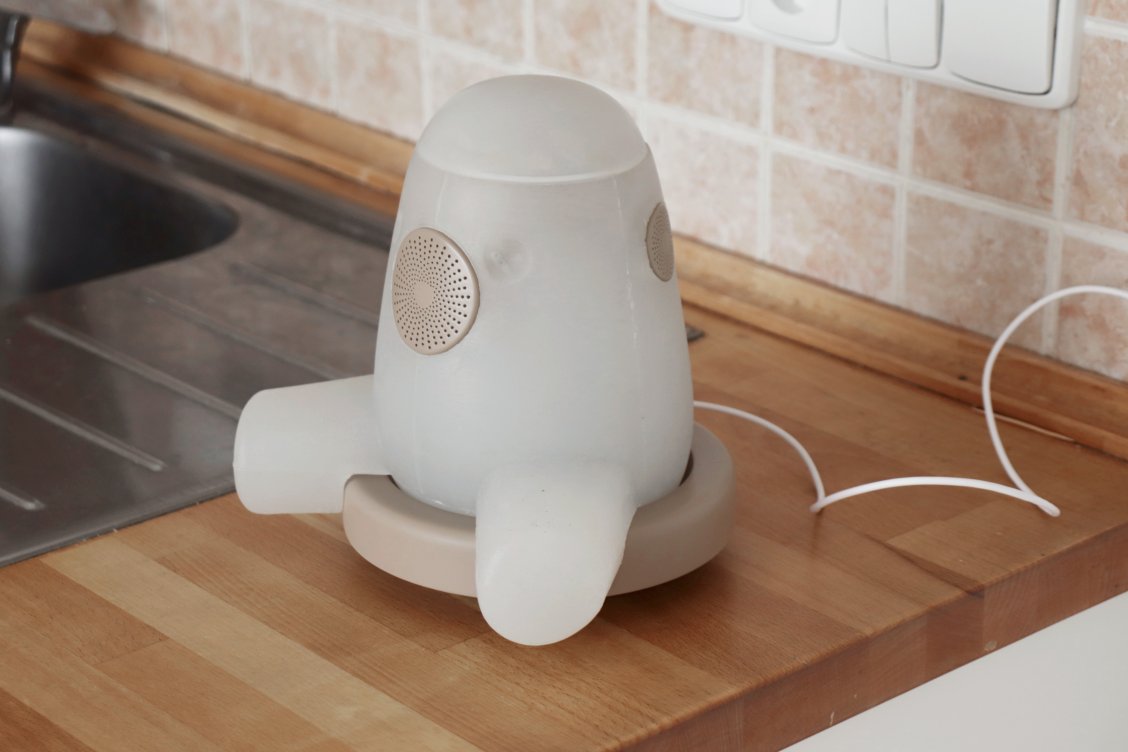
Do you want it to be a "cute" robot?
Exactly, but at the same time indeterminate. Some people see it as a character similar to the Czech children’s stories about Little Mole. According to studies, seniors tend to perceive animal traits as more acceptable and are more comfortable interacting with them. But we still need to give the user room for their own imagination, which will help them get used to the product.
Robots that look like realistic teddy bears are helping out in Japanese hospitals. This raises another ethical question: whether or not products that look almost like children's toys make the elderly act infantile. That is why I try to avoid this effect in my companion design precisely by its vagueness. In cooperation with HCI, we would like to test the communicator directly in homes for the elderly.
Do you like to devote your time to people in need?
I think it's better to use design to address vulnerable groups than to redesign popular chairs and tables over and over again. When we have the opportunity to collaborate with other faculties, it's good to come up with things that can be helpful. The population is aging and there will be more seniors.
But don’t you feel a little sorry that you're replacing dysfunctional family ties?
It can be seen that way. Unfortunately, products that provide assistance are very easy to abuse. However, people who don't relate to their loved ones and don't want to care for them will remain that way even without these helping products. My products, on the other hand, aim to provide a connection when loved ones do care but are unable to be together – whether for social reasons, economic reasons, or just because of the infectiousness of the disease.
We must not forget that as the number of elderly people increases, the number of people of working age will also decrease, and this also applies to healthcare staff. Ethical issues worry me, which is why I always try to add various safeguards to the design so that social ties are maintained.
The interview was conducted by Pavel Fuchs.
